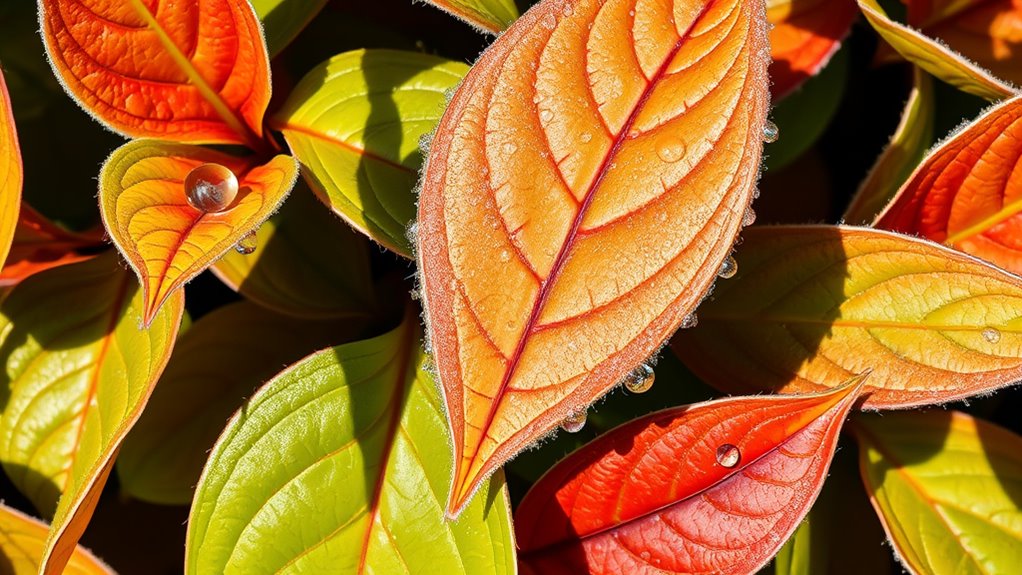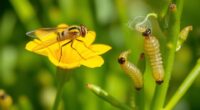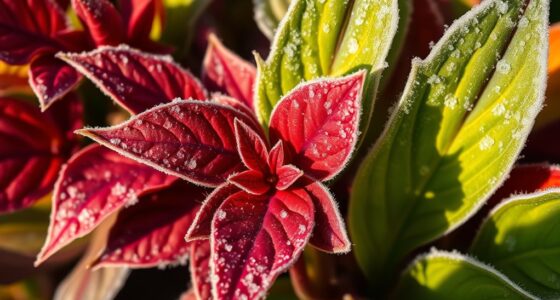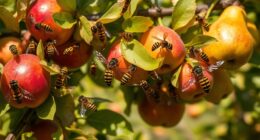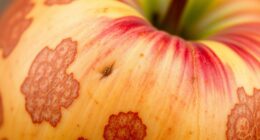If your photinia leaves turn brown, it could be due to frost damage, fungal infections, or sun scorch. Frost tends to cause browning at leaf edges with a brittle feel, while fungi often show dark spots and fuzzy coatings. Sun scorch results in crispy, brown leaf margins, especially on hot, sunny days. Environmental stress or watering issues might also cause similar symptoms. To protect your plant, understanding the cause can help you take effective action — explore further to learn more.
Key Takeaways
- Frost damage causes leaf browning starting at edges, with brittle texture and rapid color loss, often occurring after cold nights.
- Fungal infections show dark spots, moldy coatings, and leaf curling, indicating disease-related browning.
- Sun scorch results in crispy, brown leaf margins, especially on sun-facing sides during hot, sunny weather.
- Environmental stress from over- or underwatering leads to browning tips, often accompanied by wilting or leaf curling.
- Close inspection of damage patterns and symptoms helps distinguish between frost, fungal, or sun-related causes.
Recognizing Frost Damage on Photinia Leaves
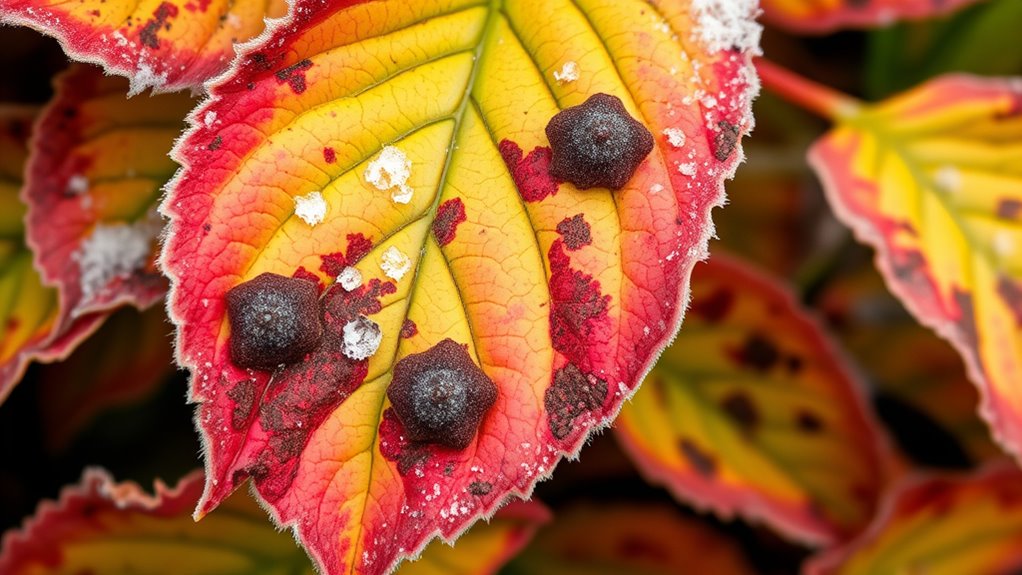
Frost damage on Photinia leaves often becomes noticeable when you see browning or blackening starting at the edges or tips of the foliage. To address this, you should start with proper pruning techniques, removing any severely damaged or dead leaves to promote healthy growth. Additionally, improving your soil can help the plant recover; consider adding soil amendments like compost or organic matter to enhance drainage and nutrient availability. Frost-damaged leaves may feel brittle and lose their vibrant color quickly, so act promptly. Keep an eye on the weather forecast to prevent further damage, and avoid overwatering, which can worsen stress. Using self watering plant pots can also help maintain consistent moisture levels, supporting overall plant health during recovery. Ensuring the plant has adequate nutrient supply is essential for quick recovery from frost injury and can be achieved through proper fertilization practices. Moreover, understanding how frost impacts plant tissues can help you better protect your Photinia in future cold spells.
Identifying Fungal Infections and Their Signs
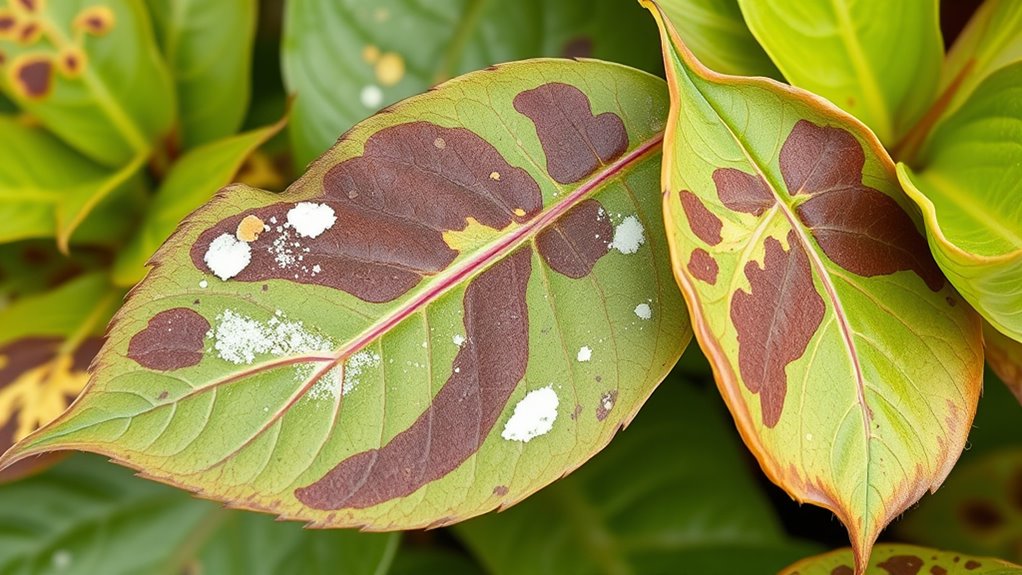
Fungal infections can often be identified by observing specific signs on your Photinia leaves. Recognizing fungal symptoms early helps prevent further damage. Look for leaf spotting, which appears as dark, irregular patches or rings on the leaves. You might also notice a powdery or fuzzy coating, indicating mold or mildew. Yellowing leaves around the spots can signal infection spreading. Additionally, infected leaves may become deformed, curl, or drop prematurely. Fungal infections thrive in humid, moist conditions, so keep an eye out for these symptoms during damp weather. Regular inspection is key. By catching leaf spotting and other fungal symptoms early, you can take appropriate action to treat the infection before it spreads further. Understanding contrast ratios can help you evaluate the severity of the damage and choose effective treatment options. Being aware of plant pathology helps you better understand the causes and prevention methods for such infections.
Detecting Sun Scorch and Excessive Heat Stress

When your Photinia is exposed to intense sunlight and high temperatures, signs of sun scorch and heat stress can quickly appear. Look for browning or browning edges on the leaves, especially on the side facing the sun. Sun scorch often causes leaf margins to turn crispy and brown, while the center may remain green. You might notice leaves curling or wilting as the plant struggles to cope with the heat. Heat stress can also cause a general decline in leaf vigor and color. If you see these symptoms during hot, sunny days, it’s likely your plant is suffering from sun scorch or heat stress. To prevent further damage, provide some shade during peak sunlight hours and ensure your Photinia stays adequately hydrated. Recognizing the signs of heat stress early can help you take steps to protect your plant from long-term damage. Additionally, understanding the plant’s sunlight tolerance can guide you in positioning it to minimize stress.
Differentiating Between Watering Issues and Environmental Stress
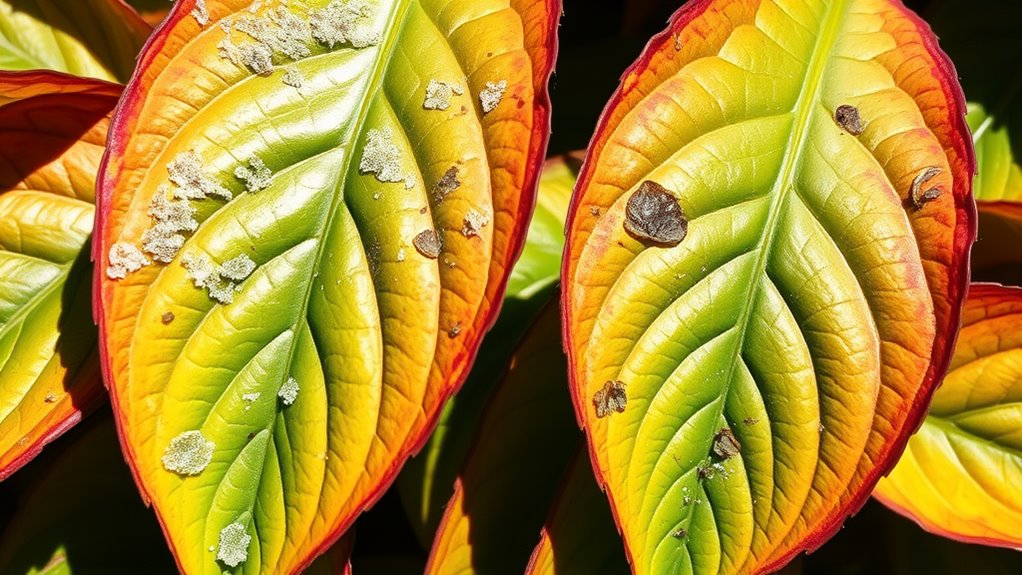
Differentiating between watering issues and environmental stress can be challenging because both can cause similar symptoms like browning leaves. To diagnose correctly, observe your Photinia’s condition carefully.
- Check your watering schedule—overwatering often leads to root rot, while underwatering causes drought stress.
- Inspect soil drainage—poor drainage traps excess water, harming roots, whereas well-draining soil prevents standing water.
- Look at watering frequency—consistent, deep watering supports healthy growth, but irregular watering can stress the plant.
- Observe leaf appearance—brown tips from overwatering or drought, and leaf scorch from environmental factors, can look alike.
Understanding these signs helps you adjust your watering practices and improve soil drainage, reducing stress on your Photinia.
Best Practices for Care During Cold Temperatures
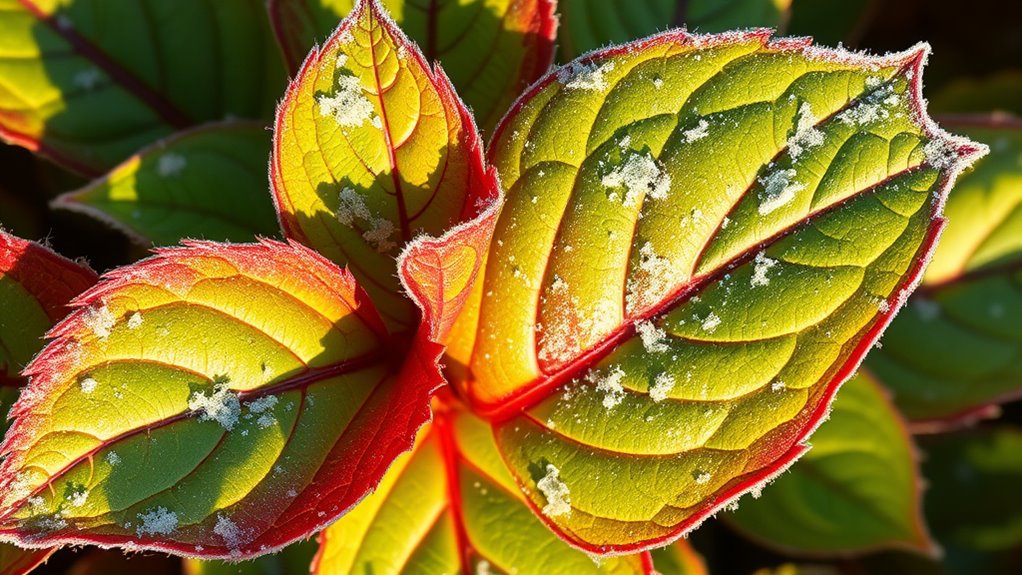
To protect your photinia during frost, cover it with frost cloths or blankets overnight. You should also adjust your watering habits, giving the plant a thorough soak before a cold snap but avoiding overwatering. These steps help minimize cold damage and keep your plant healthy through winter. Additionally, choosing the right eco-friendly practices can help reduce stress and promote overall plant health during cold periods. Ensuring proper plant care during winter months can further enhance resilience against frost damage.
Protect During Frost
Are you prepared to shield your photinia leaves from frost damage? Winter protection is essential to keep your plant healthy during cold snaps. To ensure your photinia stays resilient, especially if it’s not yet frost resistant, follow these tips:
- Cover the plant with frost cloths or blankets overnight.
- Mulch around the base to insulate roots.
- Use windbreaks to prevent cold drafts.
- Consider planting frost resistant shrubs nearby or in strategic spots for added protection.
These steps help reduce frost stress and prevent browning caused by freezing temperatures. Proper winter protection keeps your photinia thriving and minimizes leaf damage during cold weather, especially when it’s vulnerable. Understanding frost resistance and how it impacts plant health can guide you in selecting the best protection methods. Act proactively to safeguard your plant during winter’s chill, and be aware that plant hardiness plays a crucial role in winter survival.
Adjust Watering Habits
During cold temperatures, adjusting your watering habits is essential to keep your photinia healthy. Overwatering can lead to root rot, especially when the soil remains damp in cooler weather. Water only when the top inch of soil feels dry, ensuring proper drainage. Proper fertilizer application during winter can support root health without encouraging new, vulnerable growth. Additionally, use pruning techniques to remove damaged or dead branches, improving airflow and reducing disease risk. Avoid heavy pruning during cold snaps, as stress can make your plant more susceptible to browning leaves. Consistent, moderate watering combined with careful pruning helps your photinia withstand cold conditions, promoting strong, healthy foliage and minimizing browning caused by environmental stress.
Effective Treatments for Fungal Problems
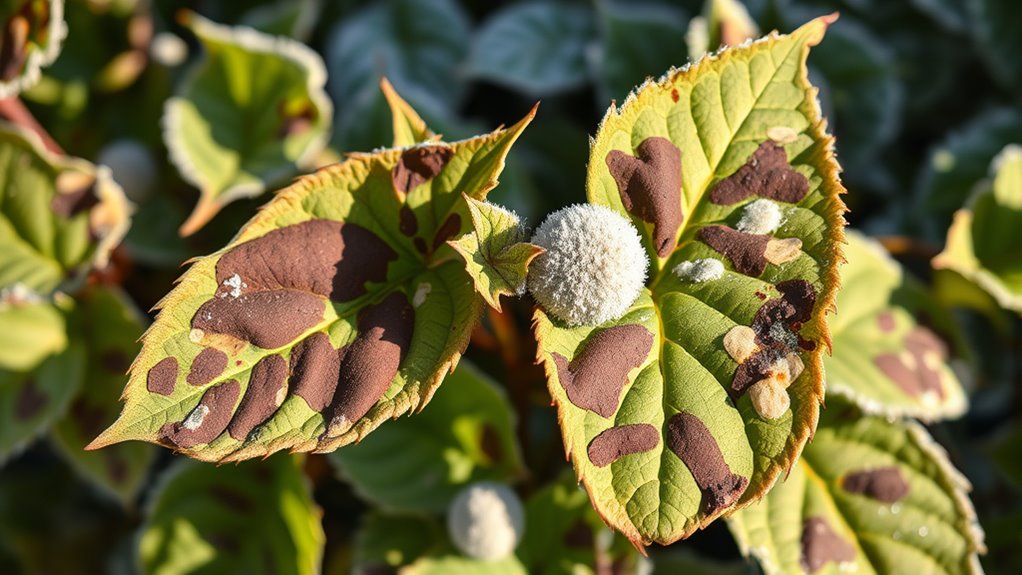
When dealing with fungal problems on photinia leaves, applying targeted treatments can effectively control the infection and prevent further damage. Start by removing and discarding infected leaves to reduce fungal spores. Use a fungicide formulated for fungal control, applying it according to the label instructions. Guarantee good airflow around your plant to decrease humidity levels that fungi thrive in. Regularly inspect your photinia for early signs of disease to catch issues early. To support disease prevention, avoid overhead watering that can spread fungal spores. Consistent updates to content signal relevancy to search engines. Here are four effective treatments:
- Remove infected foliage promptly
- Apply appropriate fungicides
- Improve air circulation
- Maintain proper watering practices
These steps will help control the fungal problem and protect your photinia’s health.
Preventative Measures to Protect Your Photinia
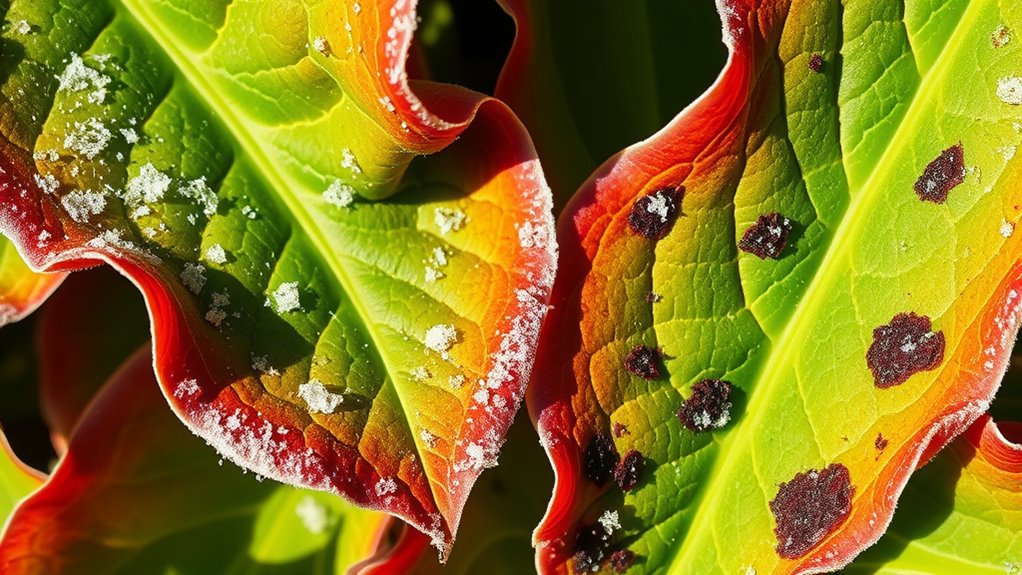
Implementing preventative measures is key to safeguarding your photinia from future fungal issues. Start by using proper pruning techniques to improve air circulation and reduce excess moisture, which fungi thrive on. Remove any dead or diseased branches promptly and avoid over-pruning, as it stresses the plant. Additionally, applying soil amendments can strengthen your photinia’s roots and enhance drainage, preventing waterlogged conditions that promote fungal growth. Use organic compost or well-draining soil mixes to improve soil health. Mulching around the base helps retain moisture and keeps weeds at bay, reducing stress on the plant. Regularly inspect your photinia for early signs of trouble, and maintain a balanced watering schedule. These preventative steps create a healthier environment, reducing the risk of leaf browning from fungi or other issues.
Frequently Asked Questions
Can Soil Conditions Influence Browning of Photinia Leaves?
Yes, soil conditions can influence browning of your photinia leaves. If the soil has improper pH levels, it can cause nutrient deficiencies, leading to leaf browning. Additionally, drainage issues can cause root rot or waterlogging, stressing the plant and resulting in leaf damage. Ensuring your soil has the right pH and good drainage helps maintain healthy roots, preventing browning and keeping your photinia vibrant.
How Does Pruning Affect Leaf Health During Stress Periods?
You should use proper pruning techniques during stress periods to promote leaf health. Avoid heavy pruning, which can weaken the plant, and instead, focus on light, targeted cuts to remove dead or damaged branches. Pruning techniques that support stress management help the plant conserve energy and recover faster. Always prune early in the season and sterilize tools to prevent disease spread, ensuring your photinia stays healthy and resilient.
Are There Specific Fertilizers to Prevent Leaf Browning?
Imagine your plant’s leaves as vibrant green waves, needing just the right nourishment. To prevent browning, choose fertilizers rich in nitrogen, phosphorus, and potassium, which promote healthy growth. Look for balanced fertilizer types that guarantee a steady nutrient supply. Proper fertilization maintains the nutrient balance your photinia craves, strengthening its resilience against stress, and keeping those leaves lush and lively instead of browning and brittle.
What Are Natural Remedies for Fungal Infections on Photinia?
You can tackle fungal infections on your photinia with natural remedies like herbal sprays and tea rinses. Spray a mixture of neem or chamomile herbal solutions directly onto the affected leaves, ensuring good coverage. Tea rinses, made from cooled chamomile or green tea, help reduce fungal growth when applied regularly. These eco-friendly options boost plant health without chemicals, helping your photinia recover naturally.
How Long Does It Take for Photinia to Recover After Damage?
When your photinia suffers damage, leaf recovery depends on environmental factors like sunlight, watering, and temperature. Typically, healthy leaves may start to recover within a few weeks, but complete recovery can take several months. To support this process, guarantee proper care—regular watering, avoiding extreme conditions, and pruning affected areas. Patience is key, as consistent care helps your plant bounce back and promotes new, healthy growth.
Conclusion
By understanding whether frost, fungus, or sun scorch is behind your photinia’s browning leaves, you can act swiftly. Imagine the vibrant green leaves turning brittle under winter’s icy grip, or dark spots spreading like shadows from fungal threats. With attentive care and proper prevention, you’ll nurture your plant back to life, watching new leaves unfurl like fresh emeralds reaching for the sun. Your photinia’s lush return begins with your mindful, loving care.
